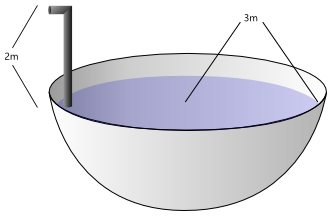Science:Math Exam Resources/Courses/MATH101/April 2012/Question 06
{{#incat:MER QGQ flag|{{#incat:MER QGH flag|{{#incat:MER QGS flag|}}}}}}
• Q1 (a) • Q1 (b) • Q1 (c) • Q1 (d) • Q1 (e) • Q1 (f) • Q1 (g) • Q1 (h) • Q1 (i) • Q1 (j) • Q2 (a) • Q2 (b) • Q3 (a) • Q3 (b) • Q3 (c) • Q3 (d) • Q4 (a) • Q4 (c) • Q5 • Q6 • Q7 (a) • Q7 (b) • Q7 (c) • Q8 (a) • Q8 (b) •
|
Make sure you understand the problem fully: What is the question asking you to do? Are there specific conditions or constraints that you should take note of? How will you know if your answer is correct from your work only? Can you rephrase the question in your own words in a way that makes sense to you? |
|
If you are stuck, check the hint below. Consider it for a while. Does it give you a new idea on how to approach the problem? If so, try it! |
Hint |
|---|
|
What is the shape of the water surface and how does it change during the process? To describe this, you need the crucial variable that changes with the process of pumping. You can use either the depth of water or the distance from the top of the bowl to the water level, but the latter will be easier. Then find a formula for the water surface so that you can find the work done to lift up a small slab of water from the water surface up to the top of the bowl and out of the outlet. |
|
Checking a solution serves two purposes: helping you if, after having used the hint, you still are stuck on the problem; or if you have solved the problem and would like to check your work.
|
Solution |
|---|
|
Denote y as the distance from the top of the bowl to the water level and r the radius of the water surface. Then, consider a right-angled triangle with a water surface radius r as base, then the height is y, and the hypoteneuse is 3, which is the radius of the bowl. (The top of the triangle is exactly at the center of the the sphere, half of which becomes the bowl). Then implies , so the area of the water surface is given as a function of y by A thin slab of water thus has volume and mass This slab of water travels a distance of y+2 to be pumped out (+2 because of the 2m vertical outlet) and requires a force of Mg Therefore, summing the work done for each slab, and letting , we get |
{{#incat:MER CT flag||
}}









![{\displaystyle {\begin{aligned}W&=\int _{0}^{3}1000\pi g(2+y)(9-y^{2})dy\\&=1000\pi g\left[\int _{0}^{3}(18+9y-2y^{2}-y^{3})dy\right]\\&=1000\pi g\left[18y+9y^{2}/2-2y^{3}/3-y^{4}/4]_{0}^{3}\right]\\&=1000\pi g\left(18\cdot 3+9(3^{2})/2-2(3^{3})/3-3^{4}/4\right)\end{aligned}}}](https://wiki.ubc.ca/api/rest_v1/media/math/render/svg/7e46e0c9303d97bfd8a7b8a1b600b07da4f17312)
